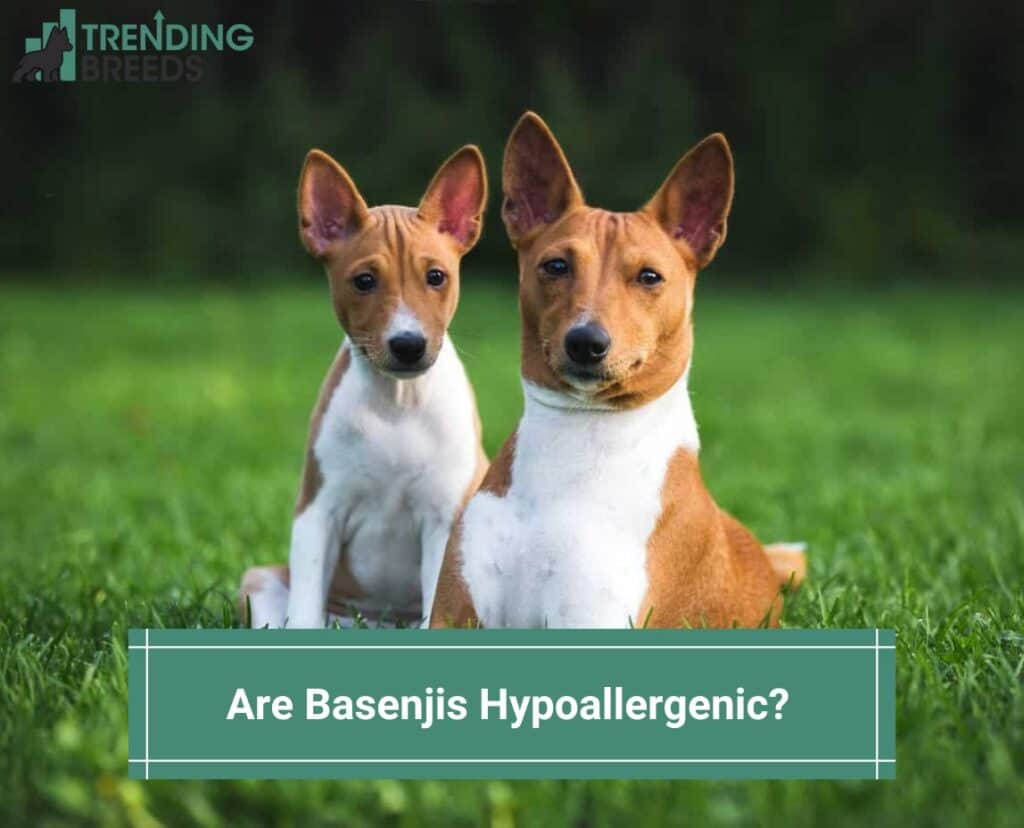
The Basenji is a small dog breed that has gained popularity in the last few years.
Basenjis are distinctive-looking with their curly tails, alert ears, and multicolored coats. They are intelligent, fiercely loyal, and eager to please. With proper socialization, they make great family pets.
If you or a loved one is allergic to dogs, you may wonder, “is a Basenji hypoallergenic?” The short answer to this is yes!
Basenjis are considered a hypoallergenic breed, so if you are looking at adopting a Basenji dog, allergies may not be something you need to worry about
Adopting a dog is a big decision, and you must consider all aspects of the dog’s life before committing. So let’s take a deeper look at these beautiful dogs and learn what makes them special.
Other articles you would like: Is A Basenji A Good First Dog? and What Colors Do Basenji Dogs Come In?
Table of Contents
What Is a Hypoallergenic Dog?
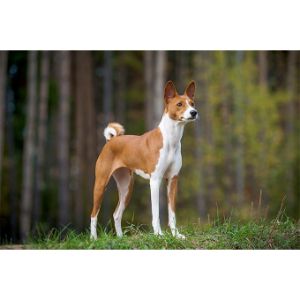
The word “hypoallergenic” has become a bit of a buzzword in the last ten years.
This is partly due to misinformation on the internet about what “hypoallergenic” actually means. It is also partly due to people spreading the myth that a 100% hypoallergenic dog exists.
Unfortunately, Basenji dogs are not 100% hypoallergenic. However, there is no such thing as a completely hypoallergenic dog. To understand more, let’s look at the science behind allergies and find out what makes a dog hypoallergenic.
Allergens and Dog Fur
Dogs produce proteins called IgE-binding proteins. It is these proteins that humans are usually allergic to. Humans who have dog allergies are allergic to one or more of these proteins. The proteins are present in dogs’ skin and saliva.
Interestingly, the proteins are typically not found in dog fur. When dogs lick themselves, the proteins in their saliva stick to their fur. When they shed, the fur becomes airborne, transferring the allergens into the air and onto surrounding surfaces.
People with dog allergies react to the presence of saliva on the fur or sometimes to dander (dead skin.) Dog dander sheds along with hair and also contains IgE-binding proteins.
There are several different proteins in animal saliva and skin. People with dander allergies are often sensitive to more than one type.
Cat allergies are twice as common as dog allergies because cats produce a specific type of protein that dogs do not. This is why some people are allergic to cats but not allergic to dogs.
“Hypoallergenic” Dogs
The word “hypoallergenic” has been misinterpreted in recent years to mean “allergy-free.” Hypoallergenic does not mean “allergy-free.”
It means “less likely to cause an allergic reaction.” A dog is hypoallergenic when it does not shed or drool much as other dogs.
Previous scientific studies indicated that the production of the IgE-binding proteins that cause allergic reactions might vary between breeds. Scientists thought that some dog breeds produced less protein than others.
However, more recent studies have disproved this theory. All dogs produce these proteins, and they all produce them at about the same rate.
There is no such thing as a 100% hypoallergenic dog, but there are breeds, like the Basenji, that might trigger a less severe allergic response in people who are allergic to the proteins in their saliva and skin.
The Basenji Breed
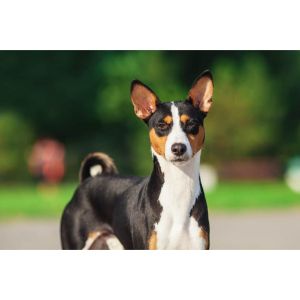
The Basenji is a small dog that originated in Africa as a hunting dog. They are sight hounds, meaning they track their prey by sight.
Like terriers, people bred them to hunt. Basenjis have lots of energy and a high prey drive and can be stubborn and difficult to train.
With proper socialization, Basenjis can make great family pets for people who are willing to commit to training them and provide adequate exercise.
Most people also consider the Basenji dog hypoallergenic, so they are a great option for people with pet allergies.
What Makes the Basenji Hypoallergenic?
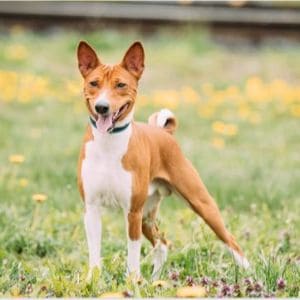
What makes Basenji dogs hypoallergenic? Three primary factors make people consider the Basenji hypoallergenic dogs: their size, lack of shedding, and lack of drooling.
Size
One of the factors in determining whether a dog is hypoallergenic is its size. This isn’t something that people often think about, but it is the most important thing to consider.
A small dog takes up less space than a big dog, so obviously, less space in your home will be affected by its hair, drool, dander, etc.
Because the Basenji is small, it has less hair than a Great Dane or German Shepherd. That means it has less hair to leave around on your couches and carpets, which means less dander for you to inhale.
Many small dog breeds are considered hypoallergenic for this reason.
Shedding
The Basenji does not shed very much. That means that you will not find too much Basenji dander or hair around your home. This makes it very easy to contain the hair (and thus, your allergic reaction) to a few areas.
Scientists previously thought that Basenji dander contained fewer IgE-binding proteins than the dander and saliva of other dogs. For a long time, this is part of why people considered the Basenji hypoallergenic dogs.
In recent years, however, this theory has been disproven. Basenji dander contains about the same amount of IgE-binding protein as the dander of other dogs.
People are less likely to have an allergic reaction to them because they are small and do not shed much.
Drooling
The IgE-binding proteins that cause allergic reactions are found in dogs’ skin and saliva.
This is why dogs that drool are often more likely to cause allergic reactions than dogs that do not drool. When dogs drool, the proteins are exposed to the environment, just like they are when dogs shed.
The Basenji is a breed that does not drool much, especially compared to other loose-lipped breeds like the Bloodhound or Bulldog.
However, many people have allergic reactions when licked by dogs. If your Basenji is a licker, it will likely cause skin irritation in people who are allergic to dogs.
The best way to prevent your Basenji from causing skin allergies is to discourage it from licking guests and family members.
Other Hypoallergenic Dog Breeds
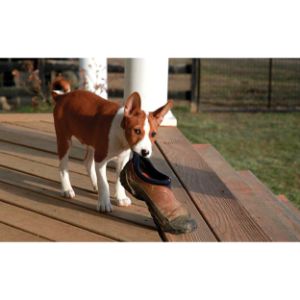
The Basenji is a strong-willed, sometimes stubborn dog that requires a lot of exercise and can be hard to train. They are not right for every household.
If you cannot provide adequate exercise for a Basenji, you may want to consider one of these other hypoallergenic breeds instead.
Bichon Frise
The Bichon Frise was specifically bred to be hypoallergenic. Their curly hair does not shed much, and they are not big droolers.
They are compact, but that doesn’t mean they don’t need exercise. The Bichon Frise is great for small living spaces but requires daily walks and plenty of attention.
Poodle
Despite its large size, the poodle is a relatively low-key breed that is easy to train. Poodles make great family pets, do not drool, and have short, curly hair that does not shed.
The poodle is such a popular hypoallergenic breed that they have been crossed with many other dogs to make trendy hybrids like the Goldendoodle, Labradoodle, Schnoodle, Cockapoo, Yorkipoo, and more.
Portuguese Water Dogs
These laid-back, playful dogs make great additions to almost any household—but they are especially great pets for people with access to water!
While the Portuguese Water Dog can adapt to any living situation, its favorite pastime is swimming, so if you decide to take one on, ensure you can provide it with access to water.
Xoloitzcuintli
This distinctive breed of dog was known as the dog of the ancient Aztecs. There is a hairless variety and a short-haired variety. While both are considered hypoallergenic, the hairless variety is likely better for those with severe allergies.
If you adopt a Xoxoitzcuintli, be aware that you must take care to protect its skin from sun damage.
Chinese Crested
The Chinese Crested is another hairless (or nearly hairless) breed with a distinctive look.
The Chinese Crested is recognizable for its tufted ears and tail, which are all the more prominent because the rest of it is hairless! They are small and relatively easy to train, making them great pets for people in small apartments.
Conclusion For Are Basenjis Hypoallergenic
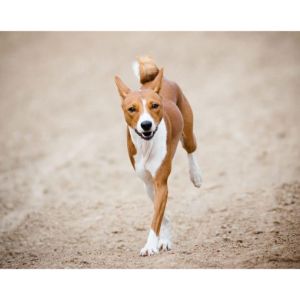
So, are Basenjis hypoallergenic?
The Basenji is considered a hypoallergenic dog, and a Basenji makes a great addition to the right household.
Basenjis are intelligent, high-energy, high-prey drive dogs that were bred to hunt and need adequate exercise and mental stimulation to thrive. They can also be stubborn and somewhat difficult to train.
If you are looking for a hypoallergenic dog breed but do not think you can commit to the training and exercise needs of a Basenji, take a look at some of the other hypoallergenic breeds available.
If you are planning to buy your dog from a breeder, always look into them to ensure you are dealing with a reputable breeder rather than a puppy mill or backyard breeder.
You may also want to consider rescuing a dog from a shelter or rescue.
Many dogs are waiting for homes at rescues and shelters, and many rescue groups specialize in particular breeds. Consider researching Basenji rescue groups in your area to find your perfect furry friend.
You will also like:
For more information about the Basenjis Breed, check out the video below:




